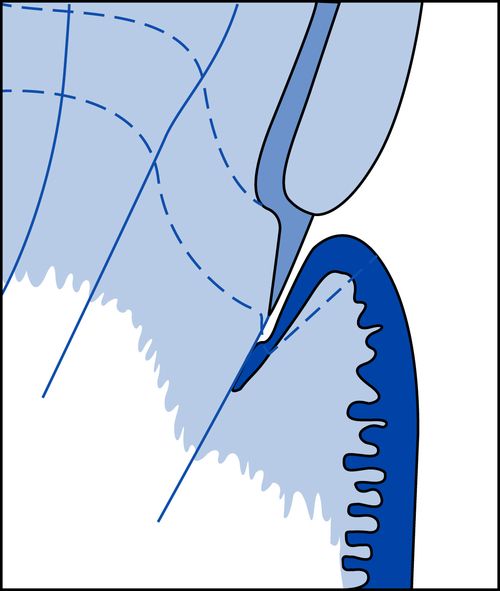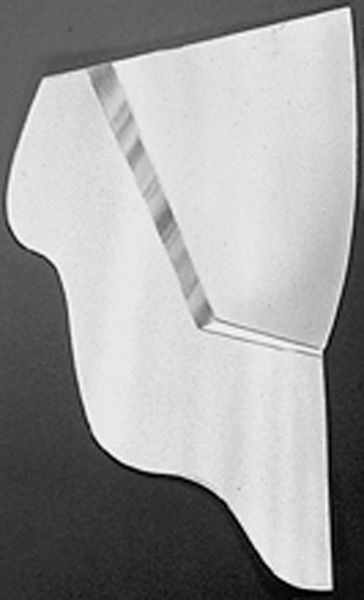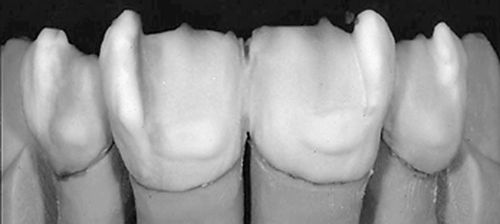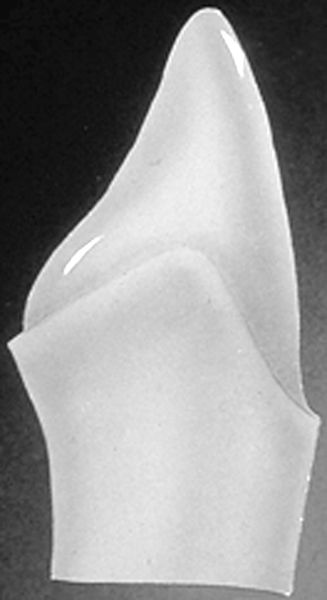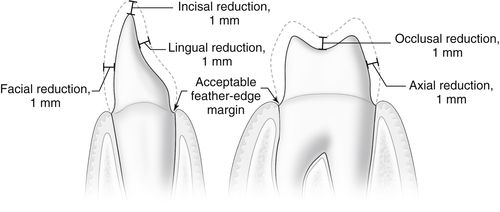5. Is the cantilever fixed bridge a sound treatment?
A cantilever fixed bridge places more torquing forces on terminal abutments than desirable. Certain guidelines should be followed if a cantilever is used:
1. Cantilever pontics are limited to one per fixed bridge.
2. If the cantilever is replacing a molar, the size of the pontic should be the same as for a bicuspid, and at least one more abutment unit should be incorporated than in a conventional bridge. In addition, there should be no lateral occlusal contact on the pontic, and the bridge should be cemented with a rigid medium.
3. If the cantilever pontic is anterior to the abutments, the mesial aspect of the pontic should be designed to allow some interlocking effect.
6. Can a three-quarter crown be used as an abutment for a fixed bridge?
A three-quarter crown can be used successfully as an abutment for a fixed bridge if certain guidelines are followed:
1. Because there is less tooth reduction than with a full crown, retention may be compromised. Internal modifications, such as grooves or pins, must be used to compensate for potential loss of retention.
2. Proper tooth coverage is necessary for a three-quarter crown abutment:
• Anterior—linguoincisal
• Posterior, upper—linguo-occlusal
• Posterior, lower—linguo-occlusal plus coverage over the buccal cusp tips
3. A three-quarter crown should be made only of metal; therefore, aesthetics may be compromised.
7. Must a post and core be constructed for an endodontically treated tooth that is to be used in a fixed bridge?
An endodontically treated tooth is generally more brittle than a vital tooth. Because of the tooth reduction for the full-crown restoration and preparation of the access cavity for the endodontic procedure, the remaining coronal tooth structure is likely to be small. Therefore, a post and core is more likely to be necessary in the anterior and bicuspid regions. If the access cavity is small and sufficient tooth structure remains after tooth preparation in the molar region, a post and core may not be necessary. In this case, the coronal chamber should be filled, preferably with a bonded material.
8. What is the proper length for the post? Should a post be made for each canal in a multirooted tooth?
In general, the length of a post should be such that the fulcrum point, determined from measuring the height of the core to the apex of the tooth, is in bone. This guideline normally places the post approximately two thirds into the root length. Improper length allows a potential for root fracture. It is not necessary to construct a post for each canal in a multirooted tooth, provided that the dominant root (i.e., palatal root of maxillary molar) is used and proper length has been established. If proper length cannot be obtained, it is necessary to place posts in at least one of the other remaining roots.
9. Can one use the preformed single-step post and core in place of the two-step cast post and core?
A preformed, single-step post and core can be used in fixed prosthodontics, but the potential for failure is greater with many of the single-step systems than with a cast gold post and core for the following reasons:
1. The canal preparation must be shaped to the configuration of the preformed post. This requirement may lead to overpreparation of the canal and potential root perforation. In contrast, a cast post is made to fit the existing configuration of the canal.
2. A screw-type post has the greatest retentive value, but also has the greatest stress forces during insertion.
3. The core buildup of the single-step post and core may not be as stable as a cast gold core.
4. If the single-step post is metal, the modulus of elasticity is normally much higher than that of the root. This may lead to root fracture during loading. In contrast, a type 3 cast gold post has a modulus of elasticity similar to that of the root.
10. Where should a crown margin be placed in relationship to the gingiva—supragingivally, equigingivally, or subgingivally?
It is better for gingival health to place a crown margin supragingivally, 1 to 2 mm above the gingival crest or equigingivally at the gingival crest. Such positioning is often not possible because of aesthetic or caries considerations. Subsequently, the margin must be placed subgingivally. The question then becomes whether the subgingival margin ends slightly below the gingival crest, in the middle of the sulcular depth, or at the base of the sulcus. In preparing a subgingival margin, the major concern is not to extend the preparation into the attachment apparatus. If the margin of the subsequent crown is extended into the attachment apparatus, a constant gingival irritant has been constructed. Therefore, for clinical simplicity, when a margin is to be placed subgingivally, it is desirable to end the tooth preparation slightly below the gingival crest (Fig. 9-2).
Materials
11. What materials are used in the construction of a full crown?
12. Are the same materials used in the construction of a fixed bridge?
In general, a fixed bridge needs a metal support for strength. The veneer coating may be acrylic, composite, or ceramic. Newer ceramic materials, including alumina, leucite, and zirconium, have increased strength that in some cases may eliminate the metal substructure.
13. What are the major advantages and disadvantages of the metal-ceramic crown?
In general, the metal-ceramic crown combines certain favorable properties of metal in its substructure and of ceramic in its veneer coating.
Advantages
1. The metal substructure gives high strength, which allows the materials to be used in fixed bridgework and for splinting teeth.
2. The fit of a metal casting can also be achieved with the metal-ceramic crown.
3. Aesthetics can be achieved by the proper application of the ceramic veneer.
Disadvantages
1. To allow enough space for the metal-ceramic materials, adequate tooth reduction is necessary (≥1.5 mm). The marginal tooth preparation is critical in relation to the design of the metal with the ceramic.
2. The fabrication technique is complex. The longer the span of bridgework, the greater the potential for metal distortion and/or porcelain problems.
14. What tooth preparation is necessary for the metal-ceramic crown?
The amount of tooth reduction necessary for the metal-ceramic crown depends on the metal and ceramic thickness. The necessary thickness of the metal is 0.5 mm, whereas the minimal ceramic thickness is 1.0 to 1.5 mm. Therefore, the tooth reduction is approximately 1.5 to 2.0 mm. With this porcelain-metal sandwich, a shoulder preparation is generally necessary for adequate tooth reduction.
15. What happens if tooth preparation or reduction is inadequate in the marginal area?
If the tooth reduction is less than 1.5 mm at the marginal area, only metal can be present in that area. If porcelain is applied on metal that has been reduced in thickness because of lack of space, marginal metal distortion is likely during the firing cycle. If the porcelain thickness is reduced to compensate for the reduced space, the opaque porcelain layer is likely to be exposed or to dominate, leading to an unaesthetic result. If both the porcelain and metal have adequate thickness, then the crown is overcontoured (Fig. 9-3).
16. Can the marginal area of a metal-ceramic crown be constructed in porcelain without metal?
There are many techniques with which to construct a porcelain margin with optimal aesthetics, proper fit, and correct contour (emergence profile).
17. If the tooth preparation is sufficient to accept the porcelain edge of the metal without distortion, why is it necessary to construct a margin in porcelain solely for aesthetic reasons?
It is possible to cover the metal correctly with porcelain in the marginal area, but most often the aesthetic results fall short of expectation in the most critical area. Incident light that transmits through the porcelain and reflects from the metal often creates a shadowing effect. If porcelain is present only at this marginal area, light transmission and reflection through the porcelain and the tooth create the proper blend between the marginal aspect of the crown and the tooth.
18. For a successful porcelain marginal construction, how far should the metal extend in relation to the shoulder?
Originally the metal was finished slightly shy of the edge of the shoulder, with porcelain extending to the edge. Another technique finished the metal at the axiocaval line angle of the preparation, creating a porcelain margin that totally covered the horizontal shoulder. With both techniques, however, shadowing was still present. To create proper light transmission and reflection of the porcelain-tooth interface, the metal should be finished to about l to 2 mm above the axiocaval line angle of the shoulder (Fig. 9-4).
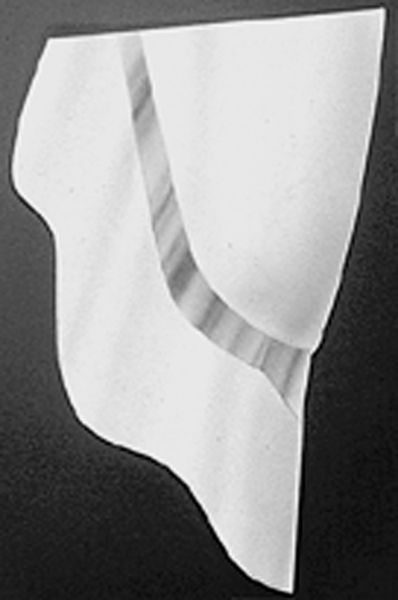
19. What are noble alloys?
Noble alloys in general do not oxidize on casting. This feature is important in a metal substrate so that oxidation at the metal-porcelain interface can be controlled by the addition of trace oxidizing elements. If oxidation cannot be controlled on repeated firings, porcelain color may be contaminated, and the bond strength may be weakened. Noble alloys are gold, platinum, and palladium. A silver alloy that oxidizes is considered semiprecious.
20. What is a base metal alloy? Can it be used in the construction of a metal-ceramic crown?
The base metal or nonprecious alloys most often used in the construction of a metal-ceramic crown are nickel and chromium. Because these alloys readily oxidize at elevated temperatures, they create porcelain to metal interface problems. The oxidation must be controlled by a metal-coating treatment, which is somewhat unpredictable. Casting and fitting are also difficult. Authorities agree that a noble alloy is preferable.
21. What are the criteria for selecting a specific alloy?
1. Compatibility of the coefficient of thermal expansion with the selected porcelains
2. Controllability of oxidation at interface
3. Ease in casting and fabrication
4. Fit potential
5. High yield of strength
6. High modulus of elasticity (stiffness) to avoid stress in the porcelain
22. How does porcelain bond to the alloy?
Ceramic adheres to metal primarily by chemical bond. A covalent bond is established by sharing O2 in the elements in the porcelain and the metal alloy. These elements include silicon dioxide (SiO2) in the porcelain and oxidizing elements such as silicon, indium, and iridium in the metal alloy.
23. How is a porcelain selected?
The criteria for selecting a specific porcelain include:
1. Compatibility with the metal used in regard to their respective coefficients of thermal expansion (of prime importance)
2. Stability of controlled shrinkage with multiple firings
3. Color stability with multiple firings
4. Capability of matching shade selection with various thicknesses of porcelain
5. Ease of handling (technique-sensitive)
6. Full range of shades and modifiers
24. How many layers or different porcelains can be applied in the buildup of a metal-ceramic crown?
25. What is the function of the opaque layer?
The elements in the opaque layer create the chemical bond of the porcelain to the metal substrate. The opaque layer masks the color of the metal and is the core color in determining the final shade of the crown.
26. What is opacious dentin?
Opacious dentin is an intermediary modifying porcelain that affords better light transmission than the opaque layer, in part because of its optical properties. Opacious dentin is less opaque than the opaque layer but less translucent than the body (dentin) porcelain. It is also used for color shifts or effect properties.
27. What differentiates shoulder porcelain from dentin (body) porcelain?
The principal difference between shoulder and body porcelain is the firing temperature. Because the shoulder porcelain is established before the general buildup, its color and dimension must remain stable during subsequent firings. Therefore, the shoulder porcelain matures at a higher temperature than the subsequent body porcelain firings.
28. What is segmental buildup in the construction of the metal-ceramic crown?
Segmental buildup refers to the method of applying the porcelain powders in incremental portions horizontally. Each increment differs from the others in opacity and translucency or hue, value, or chrome. This technique is used to construct a crown that attempts to mimic the optical properties of a natural tooth (Fig. 9-5).
29. What is the coefficient of thermal expansion? What is its importance in prosthodontics?
The coefficient of thermal expansion is the exponential expansion of a material as it is subjected to heat. The coefficient is extremely important during joint firing of two dissimilar materials. For example, the coefficient of thermal expansion should be slightly higher (rather than the same) for the metal substrate than for the porcelain coating. This slight difference results in compression of the fired porcelain coating, which gives it greater strength.
30. What is the proper coping design for the metal-ceramic restoration?
The purpose of the metal coping is to ensure the fit of the crown and maximize the strength of the porcelain veneer. The metal must have the proper thickness so as not to distort during the firing. The coping should be reinforced in load-bearing areas, such as the interproximal space and can be strengthened in areas in which metal exists alone, such as the lingual collar. To maximize the strength potential of the porcelain, uniform thickness should be attempted in the final restoration. This thickness can be obtained by designing the wax-up of the framework to accommodate the porcelain layer.
31. How does the marginal tooth preparation affect the design of the metal-ceramic crown?
The marginal tooth preparation determines the marginal configuration of the metal-ceramic crown. The three options are:
1. Beveled or feathered edge—the preparation is covered only in metal.
2. Chamfer—if the depth of the chamfer is at least 1 mm, the porcelain can extend over the metal and a supported porcelain margin can be constructed.
3. Shoulder —the preparation must be 1 mm for the porcelain to cover the metal.
32. Is the design of the metal framework of a fixed bridge different from the design of a single unit?
The design of the metal framework must incorporate four basic interrelationships—strength, aesthetics, contour, and occlusion. In fixed bridgework, however, strength of the substrate plays the dominant role. Therefore, greater attention must be paid to reinforcement of the framework than of a single unit.
33. How do design problems of the metal framework influence the function of the metal ceramic restorations?
2. If the porcelain veneer is too thick (>2 mm) because of improper framework design, much of the strength of the interface bond is lost.
3. If the porcelain veneer is too thin (≤0.75 mm), the aesthetic effect is compromised.
4. The metal framework is designed to resist deformation. If strut-type connector design is not used in the fixed bridgework, the bridge may flex and result in porcelain fracture.
34. What is metamerism? How does it affect the metal-ceramic restoration?
Metamerism is the optical property whereby two objects with the same color but different spectral reflectance curves do not match. This property is important in matching the shade of the metal-ceramic restoration to the natural tooth. Even if the colors are the same, different reflectance curves can create a barely noticeable difference.
35. What is the importance of fluorescence in porcelain?
Fluorescence is the optical property whereby a material reflects ultraviolet radiation; it reflects different hues. Natural teeth can fluoresce yellow-white to blue-white hues. Fluorescence in porcelain is important to minimize metamerism of porcelain to natural teeth in varying light conditions.
36. What are hue, value, and chroma? What is their importance in dentistry?
Color consists of three properties:
1. Hue refers to color families (e.g., red, green).
2. Value refers to lightness or darkness as related to a scale from black to white.
3. Chroma refers to the saturation of a color at any given value level.
The properties have a practical use in ordering color.
37. What is opalescence?
Opalescence is the optical property seen in an opal during light transmission and light reflection. During transmission, the opal takes on an orange-white hue, whereas during reflection it takes on a bluish-white hue. This phenomenon also occurs in the natural tooth as a result of light scattering through the crystalline structure of the opal. The structure size is in the submicron range (0.2–0.5 μm). A porcelain restoration can demonstrate the opal effect by incorporating submicron particles of porcelain into the enamel (incisal) layer.
38. How do you select a shade to match the natural teeth?
There is no truly scientific method to analyze the shade of a natural tooth and apply this information to the selection of porcelain and fabrication of the crown. Attempts to establish such a technique have met with limited success. At present, shade determination is designed to match natural teeth with a synthetic replication (shade guide) that results in a range of acceptability rather than an absolute match. The most widely used guide is the VITA Classical Shade Guide by Vident.
39. What improvements have been made in selecting a shade in more recent years?
The 3D guide was developed over 10 years ago based on the three dimensions of hue, chroma, and value. The VITA 3D-Master Shade Guide (Vident) improves accuracy in selection based on a value numbering system of 0 to 5, with 0 being the brightest and 5 the darkest shade. Chroma is also categorized from 1 to 3, with 1 being the lowest and 3 being the highest. Hue is categorized as left, middle, or right (orange to red).
Digital photography for shade analysis has also been used. Digital photography with Adobe Photoshop has been used in shade selection. Images of the compared tooth and the shade guide are taken in the same vertical plane in a RAW file format. The images are then opened in Photoshop and the background area is turned to black. A duplicate image is made and turned to gray scale. The “HSB” color model is selected in the “INFO” palette, and when the cursor is placed on the shade guide or the compared tooth, the hue will be given by an “H” number, chroma by the “S” number, and the value by the “B” number. The difference in these parameters can be measured between the tooth and the guide. The ceramist can use this information to choose the most appropriate porcelains to match the tooth structure.
Computerized digital shade technology and software are used in conjunction with visual shade guides and digital photography. Instruments store data for various shade guides and use fiberoptics along with spectrometers to aid dentists in determining the tooth shade and color zones. Light waves are sent through the tooth and refracted or reflected back to the receiver in the spectrometer. The digital spectrophotometers determine the shade, hue, chroma, and value. VITA Easyshade Compact by Vident and Crystaleye by Olympus America are two product examples.
40. Can you change a shade with external stains?
External stains or colorants are frequently used to minimize the differences between natural and ceramic teeth. They should be used rationally rather than empirically. An understanding of the color phenomenon is necessary in all aspects of shade control and is essential if extrinsic colorants are to be used correctly. Extrinsic colorants follow the physical laws of subtractive color.
41. What guidelines derived from the color phenomenon apply to the use of external colorants?
The understanding of hue, value, and chroma and their effect on external staining of a crown are essential. The major guidelines are as follows:
Hue: Drastic change of the shade of the ceramic restoration by use of external colorants is often impossible. Slight changes in shade may be accomplished (e.g., orange to orange-brown).
Value: External colorants can be used to lower the value of the ceramic. The complementary color of the shade to be altered may have a darkening effect. It is almost impossible to increase the value or shade of the ceramic.
Chroma: Chroma can be successfully increased by external colorants, usually in the gingival or interproximal areas.
42. What effects can be created with surface stains?
1. Separation and individualization with interproximal staining
2. Coloration of a cervical area to emulate root surface and produce the illusion of change of form
3. Coloration of hypocalcified areas
4. Coloration of check lines
5. Coloration of stain lines
6. Neutralization of hue for increase of apparent translucency (usually violet)
7. Highlighting and shadowing
8. Incisal edge modification—emulated opacities, high chrome areas, stain areas
9. Synthetic restorations
10. Aging
43. Are external colorants stable in the oral cavity?
External colorants are metallic oxides that fuse to the ceramic unit during a predetermined firing cycle. Although stable in an air environment, they are susceptible to corrosion when subjected to certain oral environments. Depending on the stain and pH of the oral fluids, external colorants may be lost from the ceramic unit over a long period of time.
44. What is the most important factor in determining the strength of a ceramic?
The most important factor in the strength of a ceramic material is control of small flaws or microcracks, which often are present at the surface and internally. In most cases, the strength of the ceramic depends on surface flaws rather than porosity in the normal range.
45. Should porcelain be used on the occlusal surface of a metal-ceramic crown?
In general, the surface hardness of dental porcelains is greater than that of tooth structure, metal alloys, and all other restorative materials. This may lead to excessive wear of the opposing dentition if certain occlusal guidelines are not followed. In the best scenario, the opposing material is porcelain, but results are good if the occlusal loads have good force distribution. Porcelain is contraindicated in patients who engage in bruxism or parafunctional activities in which occlusal overloading may occur.
46. Can a porcelain fracture of a metal ceramic restoration be repaired?
It is now possible to bond composite or ceramic materials to a fractured restoration. The bond, which may occur on porcelain or on the metal substrate, is sufficiently strong to be resistant in a non– or low stress-bearing area. However, if the fracture occurs in a stress-bearing area, the probability of a successful repair is low.
47. On what basis do you choose between an all-ceramic and metal-ceramic crown?
All-ceramic crowns have been frequently used. As with their predecessor, the porcelain jacket crown, which was introduced at the turn of the century, the main reason for their use is superior aesthetics. Unlike the metal-ceramic crown, which is hindered by the metal substrate, the all-ceramic crown can mimic the optical properties of the natural tooth. However, all other factors—including strength, fit, ease of fabrication, and tooth selection and preparation—may inhibit its use.
48. Is tooth preparation the same for an all-ceramic crown and metal-ceramic restoration?
The same amount of overall tooth reduction is needed for a metal-ceramic restoration as for an all-ceramic crown (1.0-1.5 mm labially, lingually, and interproximally). However, unlike the metal-ceramic restoration, which will accept any marginal design, marginal tooth preparation for the all-ceramic crown must be a shoulder or deep chamfer (minimum of 1.0 mm tooth reduction) (Fig. 9-6).
49. What tooth preparation is necessary for solid zirconia crowns?
BruxZir Solid Zirconia (Glidewell Laboratories) is a monolithic zirconia restorative material used for crowns, bridges, screw-retained implant crowns, inlays, or onlays with no porcelain overlay. The material was originally designed to provide a more durable and aesthetic alternative to posterior metal occlusal PFMs (porcelain fused to metal crowns) and cast gold restorations for demanding situations such as bruxers or restorations with limited occlusal space. These restorations are milled through CAD-CAM (computer-aided design–computer-aided manufacturing) technology and are meant to be fracture- and chip-resistant. Marginal preparation can be feather-edged and a shoulder is not necessary. A conservative preparation is indicated, similar to a full-cast gold crown, so any preparation with at least 0.5 mm of occlusal reduction is acceptable. Occlusal reduction of 1.0 mm is ideal. Labial, lingual, and interproximal reduction is 1.0 mm. Tooth preparation for a BruxZir Solid Zirconia crown is shown in Figure 9-7.
50. Can the newer all-ceramic materials with high strength values be used in place of metal-ceramic restorations?
Some manufacturers claim that the newer ceramic materials with high theoretical strength values can be used in place of metal-ceramic restorations for any tooth and for small-unit, anterior fixed bridges. However, the guidelines for usage, such as tooth preparation, are more critical and in general more complicated than for metal-ceramic restorations. It is advisable, therefore, to use the all-ceramic crown in the anterior segment, in which aesthetics is the dominant factor (Fig. 9-8).
51. What are the different types of all-ceramic crowns?
All-ceramic crowns may be categorized by composition and method of fabrication:
Composition
1. Feldspathic porcelain, such as a conventional porcelain jacket crown
Stay updated, free dental videos. Join our Telegram channel

VIDEdental - Online dental courses


